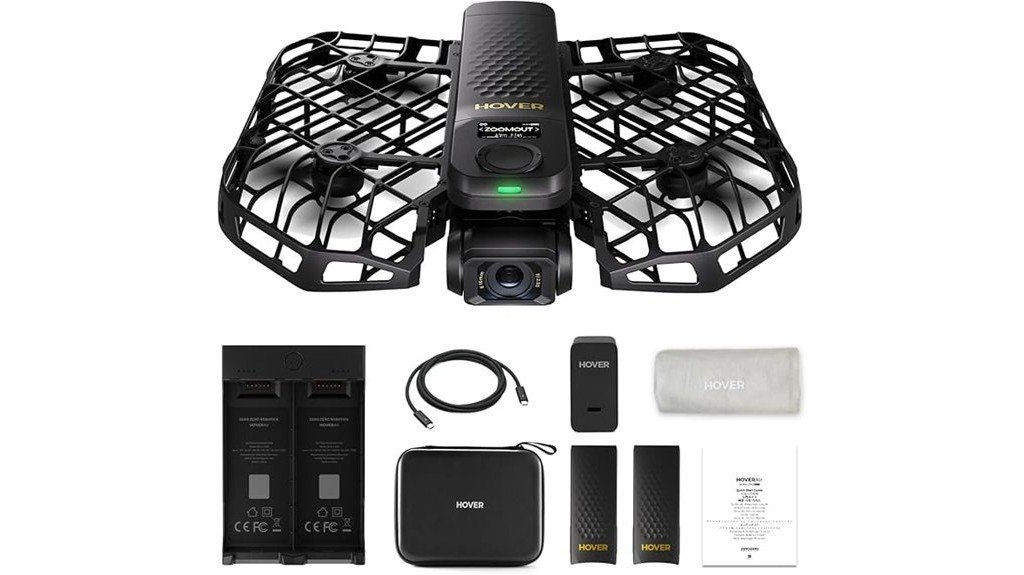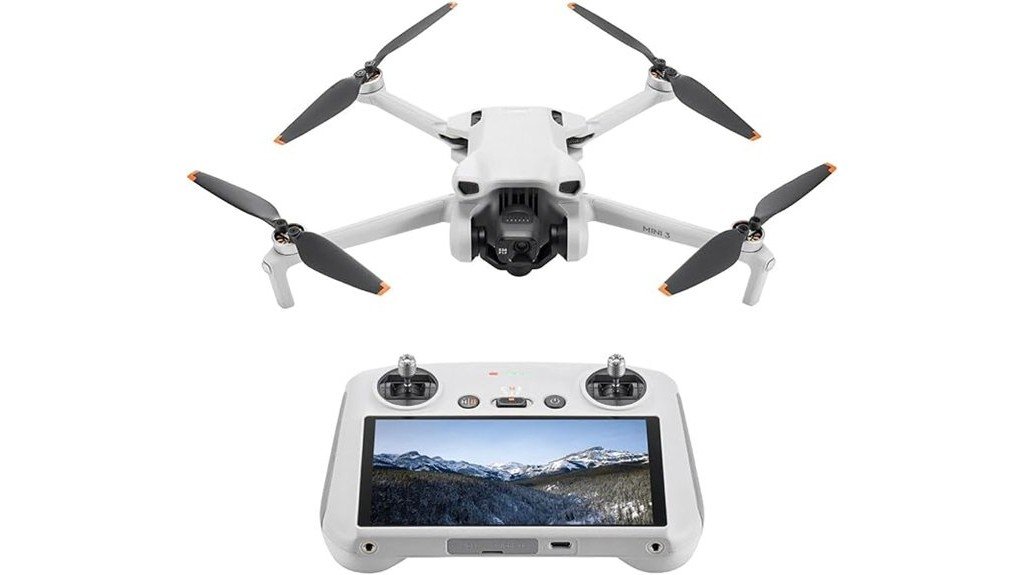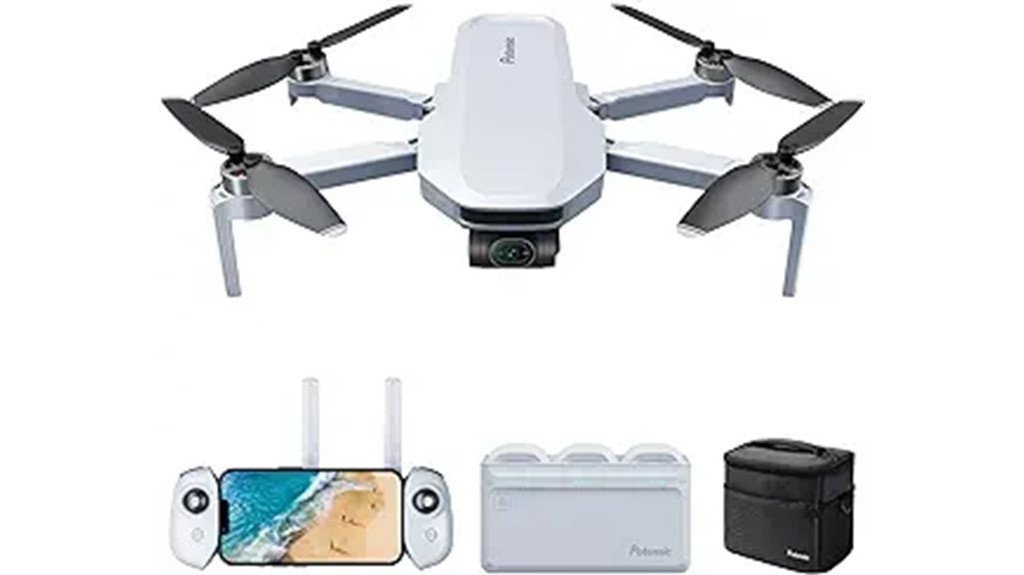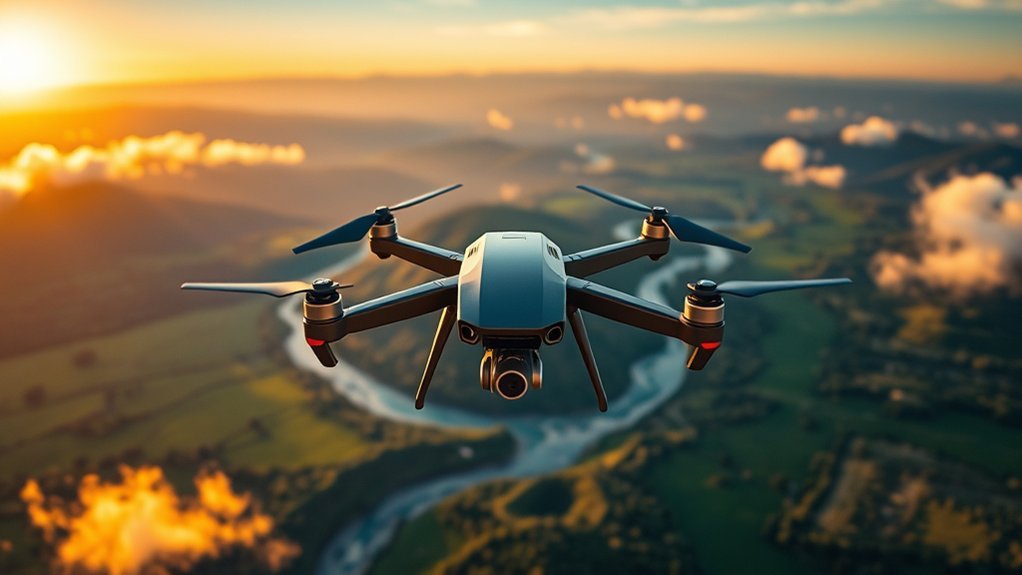In a world where breathtaking aerial shots can elevate your photography, the right drone can make all the difference. With advancements in technology, 2025 brings an impressive lineup of drones designed for stunning visuals and ease of use. From ultra-high-definition capabilities to compact designs for travel, these top five models cater to various needs. But which one will truly enhance your aerial photography experience? Let’s explore the best options available this year.
X1 PROMAX 8K Action Flying Camera Drone

If you’re looking for a drone that delivers stunning aerial photography with professional-grade capabilities, the HOVERAir X1 PROMAX 8K Action Flying Camera is a game changer. This foldable drone boasts 8K video resolution at 30fps, ensuring your shots are crystal clear. With over 10 flight modes and a follow speed of up to 42 KM/H, you can capture dynamic scenes effortlessly. Its OmniTerrain capability lets you fly over various landscapes, while the two-axis gimbal stabilizes your footage. Plus, the HOVERAir X1 app makes controlling your flight and downloading content a breeze. Elevate your photography game with this powerful drone.
Best For: Aerial photography enthusiasts and professionals seeking high-quality video and versatile flight capabilities.
Pros:
- High Resolution: Captures stunning 8K video at 30fps for exceptional imagery.
- Versatile Flight Modes: Offers over 10 flight modes for various shooting scenarios and creative angles.
- Terrain Adaptability: OmniTerrain capability allows operation in diverse environments such as snow, water, and cliffs.
Cons:
- Weight: At 3.67 pounds, it may be heavier compared to some compact drones, affecting portability.
- Battery Life: High-performance features may lead to shorter flight times, requiring extra batteries for extended use.
- Price Point: Premium features come with a higher price, which may not fit every budget.
DJI Mini 3 Drone with Camera (DJI RC)

The DJI Mini 3 Drone with Camera (DJI RC) is a fantastic choice for both aspiring photographers and seasoned professionals looking for portability without sacrificing quality. Weighing just 248 grams, it doesn’t require FAA registration for recreational use. With a flight time of up to 38 minutes and 4K UHD video capabilities, you’ll capture stunning imagery effortlessly. Its 3-axis gimbal guarantees stable shots, even in moderate wind. The foldable design makes it easy to carry, while user-friendly features like True Vertical Shooting and QuickShots enhance your creative options. Overall, it’s a versatile drone perfect for aerial photography enthusiasts.
Best For: The DJI Mini 3 Drone with Camera (DJI RC) is best for both beginners and experienced photographers seeking a compact and high-quality aerial imaging solution.
Pros:
- Excellent camera quality with 4K UHD video and Dual Native ISO for stunning imagery in various lighting conditions.
- User-friendly features such as True Vertical Shooting and QuickShots make it easy to capture creative content.
- Lightweight and portable design allows for easy transportation, making it ideal for travel and outdoor adventures.
Cons:
- Limited range of 10 km may not be sufficient for some advanced users who require longer distances.
- Battery life could be extended further, especially for those planning longer shooting sessions without access to extra batteries.
- Requires activation via the DJI Fly App, which may be an inconvenience for users who prefer a more straightforward setup.
DJI Mini 4K Camera Drone Combo

Weighing in at under 249 grams, the DJI Mini 4K Camera Drone Combo is perfect for hobbyists and aspiring photographers who want to capture stunning aerial shots without the hassle of FAA registration. With a 4K Ultra HD camera and 12 MP still resolution, your images will pop. Its 3-axis gimbal stabilization guarantees cinematic-quality footage, while the max flight time of 62 minutes with two batteries lets you shoot longer. Easy to use, it features one-tap takeoff, GPS Return to Home, and automated flight patterns. Plus, it’s wind-resistant and has an impressive 10 km transmission range, making it ideal for adventurous captures.
Best For: Hobbyists and aspiring photographers looking for a lightweight, user-friendly drone to capture high-quality aerial footage without the need for FAA registration.
Pros:
- High-quality 4K Ultra HD camera with 12 MP still resolution for stunning images.
- User-friendly features like one-tap takeoff, GPS Return to Home, and automated flight patterns make it accessible for beginners.
- Impressive battery life of up to 62 minutes with two batteries, allowing for extended shooting sessions.
Cons:
- Lacks advanced features such as collision avoidance, which may require more focus during flight.
- Limited flight time of approximately 20 minutes under typical conditions may necessitate additional batteries for longer sessions.
- App compatibility issues, as the DJI Fly app is no longer available on Google Play and must be downloaded from the official website.
Potensic ATOM 4K GPS Drone

For those seeking a compact and user-friendly drone for aerial photography, the Potensic ATOM 4K GPS Drone stands out. Weighing under 249g, it’s easy to carry in its storage bag. Its 12MP camera with a SONY CMOS sensor captures stunning 4K/30fps video, while the 3-axis brushless gimbal guarantees smooth footage, even in windy conditions. With a total flight time of 96 minutes using three batteries and a transmission range of up to 6 km, you’ll have plenty of flexibility. Plus, features like Visual Tracking and QuickShots make capturing creative shots a breeze, perfect for both beginners and pros.
Best For: The Potensic ATOM 4K GPS Drone is best for photography enthusiasts and beginners looking for a lightweight, easy-to-use drone with high-quality video capabilities.
Pros:
- Compact and lightweight design makes it highly portable.
- 4K video recording with a smooth 3-axis gimbal for stable footage.
- User-friendly features like Visual Tracking and QuickShots enhance creativity.
Cons:
- Limited to a maximum flight time of 96 minutes with three batteries.
- Transmission range may be restricted in urban areas due to interference.
- Might require some learning curve for complete beginners.
DJI Mini 3 Drone with Camera

With its lightweight design of just 248 grams, the DJI Mini 3 Drone is perfect for hobbyists and aspiring photographers who want to capture stunning aerial shots without the hassle of FAA registration. It boasts an impressive flight time of up to 38 minutes, allowing you to shoot 4K UHD video with outstanding quality, even in low light. The 3-axis mechanical gimbal guarantees stable footage, while features like True Vertical Shooting and QuickShots make capturing dynamic content a breeze. Plus, with a range of up to 10 km, you can explore and document breathtaking landscapes like never before.
Best For: Hobbyists and aspiring photographers seeking a portable and user-friendly drone to capture high-quality aerial footage.
Pros:
- Excellent video quality with 4K UHD and good low-light performance.
- Lightweight design (248 grams) eliminates the need for FAA registration.
- Impressive flight time of up to 38 minutes, extendable with additional batteries.
Cons:
- Limited to a maximum video transmission range of 10 km.
- Advanced features may require some learning for complete beginners.
- Battery life may vary based on environmental conditions and usage.
Factors to Consider When Choosing Drones for Camera Use
When you’re picking a drone for photography, several key factors matter. You’ll want to evaluate camera resolution, flight time, and gimbal stabilization to guarantee high-quality shots. Don’t forget about weight and battery management, as these will affect how easy it is to transport and operate your drone.
Camera Resolution Quality
Camera resolution quality plays an essential role in capturing stunning aerial images and videos. When choosing a drone, look for models with higher megapixels (MP) and frame rates (fps) for clearer, more detailed shots. Drones offering 4K resolution (3840 x 2160 pixels) deliver four times the detail of 1080p HD, making them perfect for professional use. Advanced sensors, like CMOS, enhance image quality by improving low-light performance and dynamic range. Don’t overlook image stabilization features, such as gimbals, which prevent blurriness and shakiness, ensuring smooth footage, even in windy conditions. Finally, consider the aspect ratio—standard 16:9 is great for widescreen videos, impacting how your images are framed and presented.
Flight Time Duration
Flight time duration is an important factor to evaluate for capturing great aerial footage. Many drones offer flight times ranging from 20 to 62 minutes, depending on battery capacity and efficiency. If you want longer shooting sessions, consider drones with larger batteries or dual battery systems, as they can greatly extend your flight time. Keep in mind that weight, environmental conditions like wind, and flight modes can all impact how long your drone stays airborne. Additionally, some drones feature intelligent battery management systems that guarantee a safe return-to-home before the battery runs low. Think about your intended use; for professional filming, longer flight times are essential to avoid interruptions during your shoots.
Gimbal Stabilization Features
Gimbal stabilization features play an essential role in achieving smooth and professional-quality aerial footage. These systems counteract unwanted movements and vibrations during flight, ensuring your videos look polished. Opt for a drone with a three-axis gimbal system, as it stabilizes along pitch, roll, and yaw axes, delivering cinematic-quality results even in windy conditions. Advanced gimbal technology, like electronic image stabilization (EIS), further enhances the stability and clarity of your recordings. Keep in mind that gimbals vary in effectiveness; higher quality systems provide more freedom of movement and better performance in dynamic filming scenarios. Ultimately, balancing stabilization capabilities with the drone’s overall design and weight is key to maximizing your aerial photography experience.
Weight and Portability
When choosing a drone for aerial photography, weight and portability are vital factors to evaluate. Drones under 250 grams often skip FAA registration, making them easier to transport and fly in various spots. Compact models around 248 grams are ideal for casual users and travelers who want convenience. Foldable designs can enhance portability, allowing you to collapse your drone into a smaller size that fits nicely in bags or cases. While lighter drones face less wind resistance, they might struggle in gusty conditions. It’s important to balance weight with battery capacity; heavier drones may provide longer flight times and stability but sacrifice some portability. Ultimately, choose a drone that suits your specific needs and flying conditions.
Battery Management Systems
Battery management systems play a pivotal role in ensuring your drone delivers peak performance for aerial photography. They optimize flight time, allowing for impressive durations of up to 62 minutes when using multiple batteries efficiently. Look for drones with intelligent battery management features that monitor voltage, temperature, and charge cycles, helping to extend battery life. Some models offer smart return-to-home (RTH) functionality, which automatically brings your drone back safely when battery levels are low. Fast charging capabilities can drastically reduce downtime, with certain drones able to recharge multiple batteries in about 1.3 hours. A well-designed battery management system can even facilitate firmware updates, enhancing both flight performance and battery efficiency over time, making it a key factor in your choice.
Intelligent Flight Modes
Intelligent flight modes can transform your aerial photography experience, making it easier to capture stunning shots with minimal effort. These modes enhance your ability to achieve dynamic and creative footage without requiring advanced piloting skills. You’ll find features like follow-me and orbiting around subjects, which automate complex maneuvers. Drones often include pre-programmed flight patterns such as Hover, Zoom Out, and Dolly Track, allowing you to focus on composition rather than control. Advanced drones utilize visual tracking, automatically adjusting their position to keep subjects in frame, even during movement. Plus, with onboard sensors for collision avoidance, you can operate safely in challenging environments. Embracing these intelligent modes can elevate your aerial photography to new heights.
Terrain Adaptability Options
Choosing a drone that adapts well to various terrains can greatly enhance your aerial photography experience. Look for models with OmniTerrain capability; they can navigate snow, water, and cliffs effortlessly, making them perfect for diverse filming settings. Advanced collision detection systems, like rear ToF sensors, help you avoid obstacles while flying at speeds up to 3m/s, ensuring safety in challenging environments. A foldable and lightweight design makes transporting your drone to remote locations a breeze. Additionally, high wind resistance ratings, such as Level 5 (up to 38 kph), guarantee stable flight in adverse weather. Finally, drones with multiple flight modes, including Hover and Dolly Track, offer versatility for capturing the best camera angles across varied terrains.

